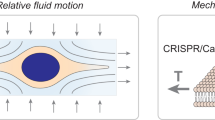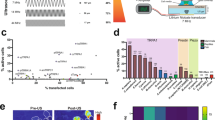Abstract
Mechanosensation, the transduction of mechanical force into electrochemical signals, allows organisms to detect touch and sound, to register movement and gravity, and to sense changes in cell volume and shape. The hair cells of the mammalian inner ear are the mechanosensors for the detection of sound and head movement. The analysis of gene function in hair cells has been hampered by the lack of an efficient gene transfer method. Here we describe a method termed injectoporation that combines tissue microinjection with electroporation to express cDNAs and shRNAs in mouse cochlear hair cells. Injectoporation allows for gene transfer into dozens of hair cells, and it is compatible with the analysis of hair cell function using imaging approaches and electrophysiology. Tissue dissection and injectoporation can be carried out within a few hours, and the tissue can be cultured for days for subsequent functional analyses.
This is a preview of subscription content, access via your institution
Access options
Subscribe to this journal
Receive 12 print issues and online access
$259.00 per year
only $21.58 per issue
Buy this article
- Purchase on Springer Link
- Instant access to full article PDF
Prices may be subject to local taxes which are calculated during checkout






Similar content being viewed by others
References
Abraira, V.E. & Ginty, D.D. The sensory neurons of touch. Neuron 79, 618–639 (2013).
Proske, U. & Gandevia, S.C. The proprioceptive senses: their roles in signaling body shape, body position and movement, and muscle force. Physiol. Rev. 92, 1651–1697 (2012).
Gillespie, P.G. & Muller, U. Mechanotransduction by hair cells: models, molecules, and mechanisms. Cell 139, 33–44 (2009).
Schwander, M., Kachar, B. & Muller, U. Review series: the cell biology of hearing. J. Cell Biol. 190, 9–20 (2010).
Dror, A.A. & Avraham, K.B. Hearing impairment: a panoply of genes and functions. Neuron 68, 293–308 (2010).
Richardson, G.P., de Monvel, J.B. & Petit, C. How the genetics of deafness illuminates auditory physiology. Ann. Rev. Physiol. 73, 311–334 (2011).
Shearer, A.E. & Smith, R.J. Genetics: advances in genetic testing for deafness. Curr. Opin. Pediatr. 24, 679–686 (2012).
Xiong, W. et al. TMHS is an integral component of the mechanotransduction machinery of cochlear hair cells. Cell 151, 1283–1295 (2012).
Bork, J.M. et al. Usher syndrome 1D and nonsyndromic autosomal recessive deafness DFNB12 are caused by allelic mutations of the novel cadherin-like gene CDH23. Am. J. Hum. Genet. 68, 26–37 (2001).
Di Palma, F. et al. Mutations in Cdh23, encoding a new type of cadherin, cause stereocilia disorganization in waltzer, the mouse model for Usher syndrome type 1D. Nat. Genet. 27, 103–107 (2001).
Bolz, H. et al. Mutation of CDH23, encoding a new member of the cadherin gene family, causes Usher syndrome type 1D. Nat. Genet. 27, 108–112 (2001).
Wada, T. et al. A point mutation in a cadherin gene, Cdh23, causes deafness in a novel mutant, Waltzer mouse niigata. Biochem. Biopyhs. Res. Commun. 283, 113–117 (2001).
Tian, L. et al. Imaging neural activity in worms, flies and mice with improved GCaMP calcium indicators. Nat. Methods 6, 875–881 (2009).
Kowalik, L. & Hudspeth, A.J. A search for factors specifying tonotopy implicates DNER in hair-cell development in the chick's cochlea. Dev. Biol. 354, 221–231 (2011).
Senthilan, P.R. et al. Drosophila auditory organ genes and genetic hearing defects. Cell 150, 1042–1054 (2012).
Shin, J.B. et al. Molecular architecture of the chick vestibular hair bundle. Nat. Neurosci. 16, 365–374 (2013).
Kralj, J.M., Douglass, A.D., Hochbaum, D.R., Maclaurin, D. & Cohen, A.E. Optical recording of action potentials in mammalian neurons using a microbial rhodopsin. Nat. Methods 9, 90–95 (2012).
Fan, X., Jin, W.Y., Lu, J., Wang, J. & Wang, Y.T. Rapid and reversible knockdown of endogenous proteins by peptide-directed lysosomal degradation. Nat. Neurosci. 17, 471–480 (2014).
Munde, P.B., Khandekar, S.P., Dive, A.M. & Sharma, A. Pathophysiology of merkel cell. J. Oral Maxillofac. Pathol. 17, 408–412 (2013).
Holt, J.R. Viral-mediated gene transfer to study the molecular physiology of the mammalian inner ear. Audiol. Neurootol. 7, 157–160 (2002).
Holt, J.R. et al. Functional expression of exogenous proteins in mammalian sensory hair cells infected with adenoviral vectors. J. Neurophys. 81, 1881–1888 (1999).
Husseman, J. & Raphael, Y. Gene therapy in the inner ear using adenovirus vectors. Adv. Otorhinolaryngol. 66, 37–51 (2009).
Bedrosian, J.C. et al. In vivo delivery of recombinant viruses to the fetal murine cochlea: transduction characteristics and long-term effects on auditory function. Mol. Ther. 14, 328–335 (2006).
Konishi, M., Kawamoto, K., Izumikawa, M., Kuriyama, H. & Yamashita, T. Gene transfer into guinea pig cochlea using adeno-associated virus vectors. J. Gene Med. 10, 610–618 (2008).
Luebke, A.E., Foster, P.K., Muller, C.D. & Peel, A.L. Cochlear function and transgene expression in the guinea pig cochlea, using adenovirus- and adeno-associated virus-directed gene transfer. Hum. Gene Ther. 12, 773–781 (2001).
Akil, O. et al. Restoration of hearing in the VGLUT3 knockout mouse using virally mediated gene therapy. Neuron 75, 283–293 (2012).
Kawashima, Y. et al. Mechanotransduction in mouse inner ear hair cells requires transmembrane channel-like genes. J. Clin. Invest. 121, 4796–4809 (2011).
Pan, B. et al. TMC1 and TMC2 are components of the mechanotransduction channel in hair cells of the mammalian inner ear. Neuron 79, 504–515 (2013).
Selot, R.S., Hareendran, S. & Jayandharan, G.R. Developing immunologically inert adeno-associated virus (AAV) vectors for gene therapy: possibilities and limitations. Curr. Pharm. Biotechnol. 14, 1072–1082 (2014).
Wu, Z., Yang, H. & Colosi, P. Effect of genome size on AAV vector packaging. Mol. Ther. 18, 80–86 (2010).
Belyantseva, I.A. Helios Gene Gun-mediated transfection of the inner ear sensory epithelium. Methods Mol. Biol. 493, 103–123 (2009).
Zhao, H., Avenarius, M.R. & Gillespie, P.G. Improved biolistic transfection of hair cells. PloS ONE 7, e46765 (2012).
Woods, C., Montcouquiol, M. & Kelley, M.W. Math1 regulates development of the sensory epithelium in the mammalian cochlea. Nat. Neurosci. 7, 1310–1318 (2004).
Zheng, J.L. & Gao, W.Q. Overexpression of Math1 induces robust production of extra hair cells in postnatal rat inner ears. Nat. Neurosci. 3, 580–586 (2000).
Brigande, J.V., Gubbels, S.P., Woessner, D.W., Jungwirth, J.J. & Bresee, C.S. Electroporation-mediated gene transfer to the developing mouse inner ear. Methods Mol. Biol. 493, 125–139 (2009).
Gulley, R.L. & Reese, T.S. Intercellular junctions in the reticular lamina of the organ of Corti. J. Neurocytol. 5, 479–507 (1976).
Nadol, J.B. Jr., Mulroy, M.J., Goodenough, D.A. & Weiss, T.F. Tight and gap junctions in a vertebrate inner ear. Am. J. Anat. 147, 281–301 (1976).
Nunes, F.D. et al. Distinct subdomain organization and molecular composition of a tight junction with adherens junction features. J. Cell Sci. 119, 4819–4827 (2006).
Li, H. et al. Correlation of expression of the actin filament-bundling protein espin with stereociliary bundle formation in the developing inner ear. J. Comp. Neurol. 468, 125–134 (2004).
Loomis, P.A. et al. Espin cross-links cause the elongation of microvillus-type parallel actin bundles in vivo. J. Cell Biol. 163, 1045–1055 (2003).
Zheng, L. et al. The deaf jerker mouse has a mutation in the gene encoding the espin actin-bundling proteins of hair cell stereocilia and lacks espins. Cell 102, 377–385 (2000).
Grillet, N. et al. Harmonin mutations cause mechanotransduction defects in cochlear hair cells. Neuron 62, 375–387 (2009).
Weil, D. et al. Usher syndrome type I G (USH1G) is caused by mutations in the gene encoding SANS, a protein that associates with the USH1C protein, harmonin. Hum. Mol. Genet. 12, 463–471 (2003).
Lefevre, G. et al. A core cochlear phenotype in USH1 mouse mutants implicates fibrous links of the hair bundle in its cohesion, orientation and differential growth. Development 135, 1427–1437 (2008).
Corey, D.P. & Hudspeth, A.J. Ionic basis of the receptor potential in a vertebrate hair cell. Nature 281, 675–677 (1979).
Frolenkov, G.I. Ion imaging in the cochlear hair cells. Methods Mol. Biol. 493, 381–399 (2009).
Beurg, M., Fettiplace, R., Nam, J.H. & Ricci, A.J. Localization of inner hair cell mechanotransducer channels using high-speed calcium imaging. Nat. Neurosci. 12, 553–558 (2009).
Farris, H.E., LeBlanc, C.L., Goswami, J. & Ricci, A.J. Probing the pore of the auditory hair cell mechanotransducer channel in turtle. J. Physiol. 558, 769–792 (2004).
Glowatzki, E., Ruppersberg, J.P., Zenner, H.P. & Rusch, A. Mechanically and ATP-induced currents of mouse outer hair cells are independent and differentially blocked by d-tubocurarine. Neuropharmacology 36, 1269–1275 (1997).
Kimitsuki, T. & Ohmori, H. Dihydrostreptomycin modifies adaptation and blocks the mechano-electric transducer in chick cochlear hair cells. Brain Res. 624, 143–150 (1993).
Jorgensen, F. & Ohmori, H. Amiloride blocks the mechano-electrical transduction channel of hair cells of the chick. J. Physiol. 403, 577–588 (1988).
Lagziel, A. et al. Spatiotemporal pattern and isoforms of cadherin 23 in wild type and waltzer mice during inner ear hair cell development. Dev. Biol. 280, 295–306 (2005).
Michel, V. et al. Cadherin 23 is a component of the transient lateral links in the developing hair bundles of cochlear sensory cells. Dev. Biol. 280, 281–294 (2005).
Siemens, J. et al. Cadherin 23 is a component of the tip link in hair-cell stereocilia. Nature 428, 950–955 (2004).
Kazmierczak, P. et al. Cadherin 23 and protocadherin 15 interact to form tip-link filaments in sensory hair cells. Nature 449, 87–91 (2007).
Pickles, J.O., Comis, S.D. & Osborne, M.P. Cross-links between stereocilia in the guinea pig organ of Corti, and their possible relation to sensory transduction. Hearing Res. 15, 103–112 (1984).
Assad, J.A., Shepherd, G.M. & Corey, D.P. Tip-link integrity and mechanical transduction in vertebrate hair cells. Neuron 7, 985–994 (1991).
Palmer, A.E. & Tsien, R.Y. Measuring calcium signaling using genetically targetable fluorescent indicators. Nat. Protoc. 1, 1057–1065 (2006).
Edelstein, A., Amodaj, N., Hoover, K., Vale, R. & Stuurman, N. Computer control of microscopes using μManager. Curr. Protoc. Mol. Biol. 92, 14.20.1–14.20.17 (2010).
Cummins, T.R., Rush, A.M., Estacion, M., Dib-Hajj, S.D. & Waxman, S.G. Voltage-clamp and current-clamp recordings from mammalian DRG neurons. Nat. Protoc. 4, 1103–1112 (2009).
Hao, J. & Delmas, P. Recording of mechanosensitive currents using piezoelectrically driven mechanostimulator. Nat. Protoc. 6, 979–990 (2011).
Caberlotto, E. et al. Usher type 1G protein sans is a critical component of the tip-link complex, a structure controlling actin polymerization in stereocilia. Proc. Natl. Acad. Sci. USA 108, 5825–5830 (2011).
Grati, M. & Kachar, B. Myosin VIIa and sans localization at stereocilia upper tip-link density implicates these Usher syndrome proteins in mechanotransduction. Proc. Natl. Acad. Sci. USA 108, 11476–11481 (2011).
Waguespack, J., Salles, F.T., Kachar, B. & Ricci, A.J. Stepwise morphological and functional maturation of mechanotransduction in rat outer hair cells. J. Neurosci. 27, 13890–13902 (2007).
Beurg, M., Evans, M.G., Hackney, C.M. & Fettiplace, R. A large-conductance calcium-selective mechanotransducer channel in mammalian cochlear hair cells. J. Neurosci. 26, 10992–11000 (2006).
Acknowledgements
We thank J. Bartles (Northwestern University) for espin-EGFP. This research was supported by funding from the US National Institutes of Health (NIH) (to U.M., DC005965 and DC007704), the Dorris Neuroscience Center (to U.M.), the Deutsche Forschungsgemeinschaft (to T.W.) and the Bundy foundation (to W.X.).
Author information
Authors and Affiliations
Contributions
W.X., T.W. and U.M. developed protocols and designed the devices; W.X., T.W., L.Y. and N.G. performed experiments; and W.X. and U.M. analyzed the data and wrote the manuscript.
Corresponding authors
Ethics declarations
Competing interests
The authors declare no competing financial interests.
Integrated supplementary information
Supplementary Figure 1 Gene transfer into supporting cells by injectoporation.
A diagram of a cross section through the organ of Corti is shown as well as the EGFP fluorescence signal in the indicated cell types. Scale bars: 10 μm.
Supplementary information
Supplementary Figure 1
Gene transfer into supporting cells by injectoporation. (PDF 467 kb)
Rights and permissions
About this article
Cite this article
Xiong, W., Wagner, T., Yan, L. et al. Using injectoporation to deliver genes to mechanosensory hair cells. Nat Protoc 9, 2438–2449 (2014). https://doi.org/10.1038/nprot.2014.168
Published:
Issue Date:
DOI: https://doi.org/10.1038/nprot.2014.168
This article is cited by
-
Improved calcium sensor GCaMP-X overcomes the calcium channel perturbations induced by the calmodulin in GCaMP
Nature Communications (2018)
-
New treatment options for hearing loss
Nature Reviews Drug Discovery (2015)
Comments
By submitting a comment you agree to abide by our Terms and Community Guidelines. If you find something abusive or that does not comply with our terms or guidelines please flag it as inappropriate.



